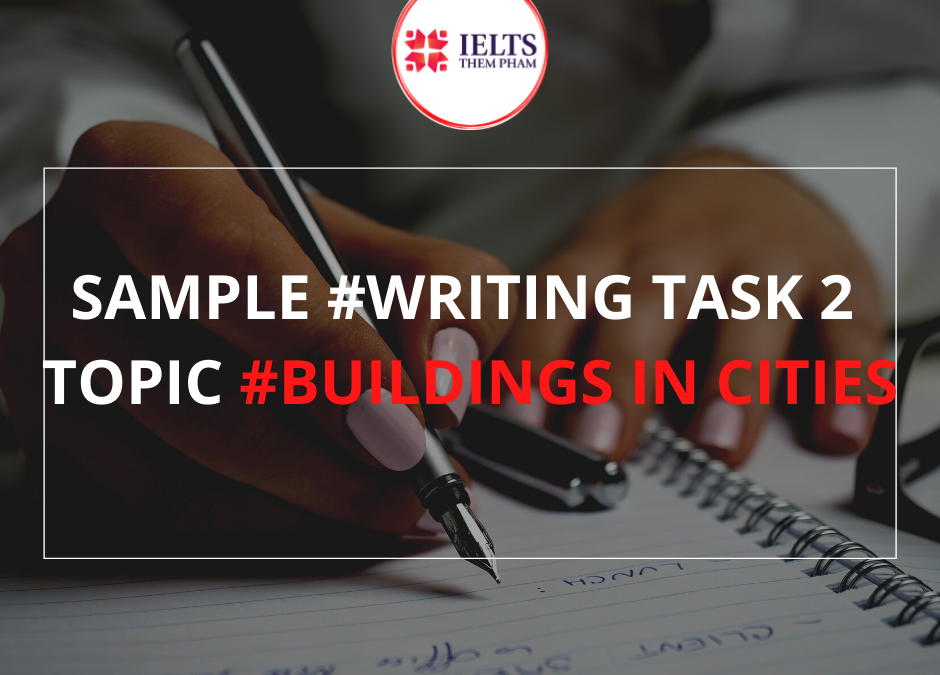SAMPLE WRITING TASK 2 TOPIC BUILDINGS IN CITIES

SERIES TẤT TẦN TẬT VOCAB CHO #IELTS WRITING TASK 1 BAND 7.0-8.0+ (Part 2)
Tháng Mười Hai 22, 2020
SERIES TẤT TẦN TẬT VOCAB CHO #IELTS WRITING TASK 1 BAND 7.0-8.0+ (Part 2)
Tháng Mười Hai 26, 2020SAMPLE WRITING TASK 2 TOPIC BUILDINGS IN CITIES
Question: Some cities create housing for growing populations by building taller buildings while other cities have opted to build on wider areas of land.
Which solution is better?
Answer:
Many cities today are expanding upwards to accommodate surging urban populations. In my opinion, this can help preserve nearby land for other uses and is a better solution than encouraging urban sprawl.
Some would argue that tall cities present challenges for inhabitants and a spread-out city offers better quality of life. Condensed urban areas with lots of tall apartment blocks, like in New York City or Shanghai, are famously difficult to live in due to the effects of overcrowding on sanitation, safety, and traffic conditions. In contrast, decentralised cities like Los Angeles and Nashville allow for the development of unique individual neighborhoods, more space for residential construction and a reduction of the urban issues listed above. Individuals living in these cities often report greater feelings of satisfaction and many ‘transplants‘ move to such cities because of the better living standards.
However, those in favour of taller buildings can logically point out the resultant benefits for the area around a city. It is often hard to check the growth of economically important cities and that can lead to massive urban sprawl, as is in the case around Mexico City and Tokyo. By building more skyscrapers, the surrounding area can be preserved or used in another way. Pristine natural lands can be designated as national parks. If the city requires more food to feed its population, there could be proximately located farms with fast delivery times. This surplus land could also be turned into quiet suburban towns to give residents the choice of raising a family outside the city and still earning a good wage and having easy access to the cultural benefits of large metropolises.
In conclusion, horizontal cities facilitate some positive living conditions but taller cities make more sense in the modern world. It is, nonetheless, important to strike a balance and mitigate the issues caused by growing urban populations with quality infrastructure.
LEXICAL RESOURCES BAND 8.0+
Cities expand upwards: mở rộng theo chiều dọc (=tall cities, build more skyscrapers)
Spread-out city: thành phố mở rộng theo chiều ngang (=urban sprawl = decentralized cities = horizontal)
Surging urban population: dân số đô thị đang phát triển
Sth presents challenges for sth: đưa ra thách thức/vđ gì
Condensed urban areas: thành phố đông đúc
Sanitation: vệ sinh
Allow space for residential construction: cho phép nhiều không gian cho xây dựng khu dân cư
Report greater feeling of satisfaction: thể hiện cảm xúc hài lòng
Be in favor of sth: ủng hộ điều j
Logically point out = designate: chỉ ra cái gì
The resultant benefits: lợi ích
Pristine natural lands: những vùng đất tự nhiên
Proximately located farms: những nông trại gần đó
Turn into sth: biến thành
Give sb the choice of sth: đưa cho ai đó cơ hội
Raising a family: nuôi gia đình
Earn a good wage: kiếm được nhiều tiền
Cultural benefits: lợi ích văn hoá
Facilitate positive living conditions: trang bị điều kiện sống tích cực
Make more sense: khả thi hơn/tốt hơn
Strike a balance: tạo ra sự cân bằng
Mitigate the issues: giảm thiểu vấn đề





